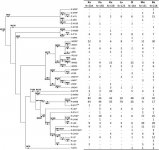https://www.nature.com/articles/ejhg2012190 - "Contemporary paternal genetic landscape of Polish and German populations: from early medieval Slavic expansion to post-World War II resettlements"
In that study Slavic population from Poland (from regions: Kaszuby, Kociewie and Kurpie) have well above 50% of R1a. Slovakian sample has relatively low share of M458 (about 16%) and quite significantly less R1a (about 45%) than Polish populations. Sample from western Bavaria has relatively large amount of M458 (17 samples) in comparison to R1axM458 (10 samples). Why there is relatively large share of M458 and R1a in western (not eastern) part of Bavaria?
Population of Upper Sorbian speakers from eastern Germany have above 56% of M458 in Y-DNA. So Sorbs look to be more Polish than Poles
I noticed something interesting in U106 subclades distribution. Kashubians have 9 U106>L48 samples and only 1 other sample of U106 (U106*). In neighboring Kociewie region there are 10 samples of U106* (U106xL48xU198) and 4 samples of L48 and 1 sample of U106>U198. Sorbs have 1 sample of U106xL48 and 5 samples of L48. In Kurpie and western Slovakia there are the same amounts of U106xL48 and L48 (3 U106* and 3 L48 in Kurpie, 6 U106* and 6 L48 in Slovakia).
In Mecklenburg and Bavaria there are relatively small differences between U106>L48 and U106xL48 (they are, of course, more common than among Slavic populations). Mecklenburg has 17 U106* (xL48) and 20 L48 samples, Bavaria has 20 U106>L48 samples and 26 samples of U106xL48.
https://media.nature.com/m685/nature-assets/ejhg/journal/v21/n4/images/ejhg2012190f1.jpg
In that study Slavic population from Poland (from regions: Kaszuby, Kociewie and Kurpie) have well above 50% of R1a. Slovakian sample has relatively low share of M458 (about 16%) and quite significantly less R1a (about 45%) than Polish populations. Sample from western Bavaria has relatively large amount of M458 (17 samples) in comparison to R1axM458 (10 samples). Why there is relatively large share of M458 and R1a in western (not eastern) part of Bavaria?
Population of Upper Sorbian speakers from eastern Germany have above 56% of M458 in Y-DNA. So Sorbs look to be more Polish than Poles
I noticed something interesting in U106 subclades distribution. Kashubians have 9 U106>L48 samples and only 1 other sample of U106 (U106*). In neighboring Kociewie region there are 10 samples of U106* (U106xL48xU198) and 4 samples of L48 and 1 sample of U106>U198. Sorbs have 1 sample of U106xL48 and 5 samples of L48. In Kurpie and western Slovakia there are the same amounts of U106xL48 and L48 (3 U106* and 3 L48 in Kurpie, 6 U106* and 6 L48 in Slovakia).
In Mecklenburg and Bavaria there are relatively small differences between U106>L48 and U106xL48 (they are, of course, more common than among Slavic populations). Mecklenburg has 17 U106* (xL48) and 20 L48 samples, Bavaria has 20 U106>L48 samples and 26 samples of U106xL48.
https://media.nature.com/m685/nature-assets/ejhg/journal/v21/n4/images/ejhg2012190f1.jpg


